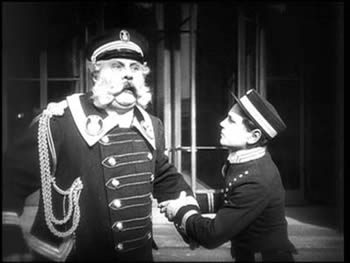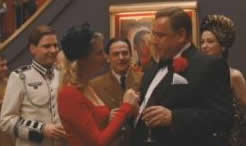The Last Laugh (1924)
 Directed by F. W. Murnau, an example of kammerspielfilm with some elements of expressionism.
Directed by F. W. Murnau, an example of kammerspielfilm with some elements of expressionism.
Critics often see many of the German films of this era as prefiguring the rise of the Third Reich. This is no exception. As Roger Ebert says in the review linked below, the critic Lotte Eisner wrote that the central tragedy of the movie "could only be a German story. It could only happen in a country where the uniform (as it was at the time the film was made) was more than God." Ebert continues: "Perhaps the doorman's total identification with his job, his position, his uniform and his image helps foreshadow the rise of the Nazi Party; once he puts on his uniform, the doorman is no longer an individual but a slavishly loyal instrument of a larger organization. And when he takes the uniform off, he ceases to exist, even in his own eyes."
Written by Carl Mayer (1894-1944). Meyer worked on most of F. W. Murnau's films and was also one of the writers for Robert Wiene's 1920 landmark film The Cabinet of Dr. Caligari. Meyer was Jewish and a pacifist. He had an impoverished childhood after his father lost his money gambling. Psychologically troubled himself, Mayer found a home in the deeply psychological film making of German Expressionism, particularly with Murnau. Mayer's scripts were deeply concerned with camera movement and he treated the camera like a character. Mayer continued to write for Murnau after Murnau went to Hollywood. However, Mayer refused to leave Germany at that time. He did leave a few years later, in 1933. After the rise of the Nazis he escaped to London. He did some work with the British film industry but was not very successful there and died in poverty in 1944.
Camera, Karl Freund (1890-1969). Freund, who was also Jewish, was instrumental in developing the camera style for German Expressionism. In The Last Laugh Freund pioneers both Point of View (POV) and flying boom shots. His technique is called "unchained camera" and is considered a critical innovation in cinematography. Freund moved to the US in 1929. where he worked both as a director and a cinematographer. In addition to doing cinematography for many movies, including the classic noir, Key Largo (1948). He directed Belaa Lugosi in Dracula (1931, uncredited) and Boris Karloff in The Mummy (1932). Between his work in Germany and the US, he did camera work on more than 100 films. In the 1950s, Freund was the cinematographer for the I Love Lucy sitcom. In that role he perfected the three camera technique and invented the lighting system that is still in use in filming live sitcoms today..
 Starring: Emil Jannings (1884-1950) as the doorman. Jannings was an actor in Reinhardt's company. He appeared in a series of critical films in the late 1920s including The Last Command (1928) and Blue Angel (1930). He stared in Hollywood in the 20s and, in 1929 won the Oscar for Best Actor for Way of All Flesh (1927) and The Last Command (1928) (in those days you could win for multiple performances). However, when sound arrived, Jannings' thick German accent made it impossible for him to work in American films. He returned to Germany where he became an enthusiastic Nazi (though he was not a party member). He starred in numerous propaganda films. He was one of Hitler's favorite actors, was awarded a medal by Goebbels, and made "Artist of the State" in 1941. After the end of the war he was blacklisted by the Allies and prevented from making further films. In the trivia department: Jannings (played by Hilmar Eichhorn) makes a brief appearance in Quentin Tarantino's 2009 Inglourious Basterds (photo left).
Starring: Emil Jannings (1884-1950) as the doorman. Jannings was an actor in Reinhardt's company. He appeared in a series of critical films in the late 1920s including The Last Command (1928) and Blue Angel (1930). He stared in Hollywood in the 20s and, in 1929 won the Oscar for Best Actor for Way of All Flesh (1927) and The Last Command (1928) (in those days you could win for multiple performances). However, when sound arrived, Jannings' thick German accent made it impossible for him to work in American films. He returned to Germany where he became an enthusiastic Nazi (though he was not a party member). He starred in numerous propaganda films. He was one of Hitler's favorite actors, was awarded a medal by Goebbels, and made "Artist of the State" in 1941. After the end of the war he was blacklisted by the Allies and prevented from making further films. In the trivia department: Jannings (played by Hilmar Eichhorn) makes a brief appearance in Quentin Tarantino's 2009 Inglourious Basterds (photo left).
 Read a review of the film by Roger Ebert:
Read a review of the film by Roger Ebert: